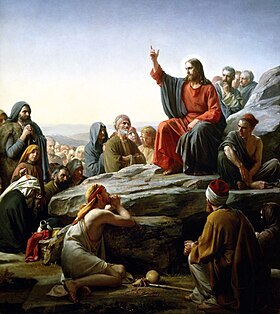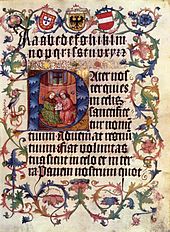Sermon on the Mount

canonical gospels |
 |
|
Portals: |
The Sermon on the Mount (
Background and setting
The Sermon on the Mount is placed relatively early in Matthew's portrayal of Jesus's ministry--following, in chapter 3, his baptism by John and, in chapter 4, his sojourn and temptation in the desert, his call of four disciples, and his early preaching in Galilee.
The five discourses in the Gospel of Matthew are: the Sermon on the Mount (5-7), the discourse on discipleship (10), the discourse of parables (13), the discourse on the community of faith (18), and the discourse on future events (24-25).[4] Also, like all the other "discourses," this one has Matthew's concluding statement (7:28-29) that distinguishes it from the material that follows. For similar statements at the end of the other discourses, see 11:1; 13:53; 19:1; 26:1.
Traditionally, the Mount of Beatitudes has been commemorated as the physical site at which the sermon took place. Other locations, such as Mount Arbel and the Horns of Hattin, have also been suggested as possibilities.
This sermon is one of the most widely quoted sections of the
The setting for the sermon is given in
Components

Although the issues of Matthew's compositional plan for the Sermon on the Mount remain unresolved among scholars, its structural components are clear.[6][7]
Matthew 5:3–12[8] includes the Beatitudes. These describe the character of the people of the Kingdom of Heaven, expressed as "blessings".[9] The Greek word most versions of the Gospel render as "blessed," can also be translated "happy" (Matthew 5:3–12 in Young's Literal Translation[10] for an example). In Matthew, there are eight (or nine) blessings, while in Luke there are four, followed by four woes.[9]
In almost all cases, the phrases used in the Beatitudes are familiar from an Old Testament context, but in the sermon Jesus gives them new meaning.[11] Together, the Beatitudes present a new set of ideals that focus on love and humility rather than force and mastery; they echo the highest ideals of Jesus's teachings on spirituality and compassion.[11]
In Christian teachings, the
Matthew 5:13–16[14] presents the metaphors of salt and light. This completes the profile of God's people presented in the beatitudes and acts as the introduction to the next section.
There are two parts in this section, using the terms "salt of the earth" and Light of the World to refer to the disciples – implying their value. Elsewhere, in John 8:12,[15] Jesus applies 'Light of the World' to himself.[16]
Jesus preaches about Hell and what Hell is like: "But I say unto you, That whosoever is angry with his brother without a cause shall be in danger of the judgment: and whosoever shall say to his brother "Raca (fool)" shall be in danger of the council: but whosoever shall say, Thou fool, shall be in danger of hell fire."[17]

The longest section of the Sermon is Matthew 5:17–48,
In
The first part of Matthew 7 (Matthew 7:1–6)[25] deals with judging. Jesus condemns those who judge others without first sorting out their own affairs on the matter: "Judge not, that ye be not judged." Jesus concludes the sermon in Matthew 7:17–29[26] by warning against false prophets.
Teachings and theology

The teachings of the Sermon on the Mount have been a key element of Christian ethics, and for centuries the sermon has acted as a fundamental recipe for the conduct of the followers of Jesus.[27] Various religious and moral thinkers (e.g. Leo Tolstoy and Mahatma Gandhi) have admired its message, and it has been one of the main sources of Christian pacifism.[1][28]
In the 5th century,
If anyone will piously and soberly consider the sermon which our Lord Jesus Christ spoke on the mount, as we read it in the Gospel according to Matthew, I think that he will find in it, so far as regards the highest morals, a perfect standard of the Christian life.
The last verse of chapter 5 of Matthew (Matthew 5:48)
The teachings of the sermon are often referred to as the "Ethics of the Kingdom": they place a high level of emphasis on "purity of the heart" and embody the basic standard of Christian righteousness.[32]
Theological structure
The theological structure of the Sermon on the Mount is widely discussed.
Interpretation
This section may require cleanup to meet Wikipedia's quality standards. The specific problem is: This section does not explain what these interpretations mean in terms of the sermon. (April 2020) |
The high ethical standards of the Sermon have been interpreted in a wide variety of ways by different Christian groups.
North American Biblical scholar Craig S. Keener finds at least 36 different interpretations of the message of the Sermon which he groups into eight views:[35]
- The predominant medieval view, "reserving a higher ethic for clergy, especially in monastic orders"[36]
- A view associated with Martin Luther that it represents an impossible demand, but serves to educate Christians on the ideals of their faith[37]
- The Anabaptist a literal view which directly applies the teachings[38]
- The Social Gospel view[clarification needed]
- The Christian existentialism view[clarification needed]
- Schweitzer's view of an imminent eschatology referring to an interim ethic
- Dispensational eschatology which refers to the future Kingdom of God
- Inaugurated eschatology in which the Sermon's ethics remain a goal to be approached, yet realized later
Comparison with the Sermon on the Plain
While Matthew groups Jesus's teachings into sets of similar material, the same material is scattered when found in Luke.[1] The Sermon on the Mount may be compared with the similar but shorter Sermon on the Plain as recounted by the Gospel of Luke (Luke 6:17–49), which occurs at the same moment in Luke's narrative, and also features Jesus heading up a mountain, but giving the sermon on the way down at a level spot. Some scholars believe that they are the same sermon, while others hold that Jesus frequently preached similar themes in different places.[39]
See also
- Gospel harmony
- Jesus in Christianity
- Life of Jesus in the New Testament
- The Kingdom of God Is Within You, 1894 Leo Tolstoy book
References
Footnotes
- ^ a b c Cross, F.L., ed. (2005), "Sermon on the Mount", The Oxford dictionary of The Christian church, New York: Oxford University Press.
- ISBN 9783161541025.
- ^ ISBN 978-0-918954-76-3. pages xi–xiv.
- ISBN 978-0-8028-6498-7pp. 37–38.
- ^ Although the speeches in Matthew 5-7 and in Luke 6 both begin with beatitudes and end with the parable of the two builders, the settings are interestingly different but involve the same components. Whereas Matthew has Jesus go up the mountain with his disciples, sit, and deliver his speech to the crowds, Luke (6:17) describes him coming down from the mountain with his disciples, standing on a level place, and speaking to the crowds.
- ^ ISBN 1-57003-553-9pp. 21–26.
- ^ ISBN 0-8091-3473-Xpp. 35–47.
- ^ Matthew 5:3–12
- ^ ISBN 978-0-19280290-3
- ^ Matthew 5:3–12
- ^ ISBN 1-4102-1730-2pages 15–19.
- ISBN 0-934134-36-7pages 68–71.
- ISBN 1-931018-31-6, pages 63–68
- ^ Matthew 5:13–16
- ^ John 8:12
- ISBN 0-7661-7467-0.
- ^ Matthew 5:22
- ^ Matthew 5:17–48
- ^ See David Flusser, "The Torah in the Sermon on the Mount" (WholeStones.org) and idem, "'It Is Said to the Elders': On the Interpretation of the So-called Antitheses in the Sermon on the Mount" (JerusalemPerspective.com).
- ^ Matthew 7:24–27
- ISBN 978-0-80282501-8.
- ^ 1 Chronicles 29:10–18
- ISBN 978-0-9778737-1-5
- ^ Stevenson (2004), p. 198.
- ^ Matthew 7:1–6
- ^ Matthew 7:17–29
- ISBN 0-8132-0818-1page 134
- ^ For Tolstoy, see My Religion, 1885. cf. My Religion on Wikisource.
- ^ Matthew 5:48
- ^ ISBN 9781438422800.
- ISBN 9780801031922.
- ISBN 81-8069-363-5.
- ^ JSTOR 3261066.
- ^ Stassen, Glen H. "The Fourteen Triads of the Sermon on the Mount." Journal of Biblical Literature, 2003.
- ISBN 978-0-8028-6498-7.
- ^ Mahoney, Jack (February 2012). "Catholicism Pure and Simple". 2nd, 3rd, and 4th paragraphs.
The most widespread and notorious of these strategies was the double standard approach which developed by the time of the Middle Ages, requiring the sermon to be taken seriously by only some members of the Church.
{{cite web}}: CS1 maint: location (link) - S2CID 170623512.
The notion that the Sermon is impossible of fulfillment, but has a pedagogical function, is usually associated with Martin Luther or, as Jeremias puts it, with "Lutheran orthodoxy." However, Luther himself maintained that faith is active in works of love and that it is precisely faith which loving service presupposes and of which it is a sign. For this reason, Jeremias's own hermeneutic of the Sermon carries through Luther's most central insights. The Sermon indicates a way of life which presupposes conversion; the Sermon's portrayals of discipleship, while not literal prescriptions, create ideals and set burdens of proof for all concrete embodiments.
- ^ "Global Anabaptist Mennonite Encyclopedia Online (GAMEO)". first paragraph.
Whereas Luther emphasized salvation by faith and grace alone, the Anabaptists placed emphasis on the obedience of faith.
- ^ Ehrman 2004, p. 101
Sources
- Augustine of Hippo (1885). . Ante-Nicene Christian Library, Volume VI. Translated by William Findlay. T. & T. Clark in Edinburgh.
- Baxter, Roger (1823). . Meditations For Every Day In The Year. New York: Benziger Brothers. pp. 368–389.
- Betz, Hans Dieter (1985). Essays on the Sermon on the Mount. Philadelphia: Fortress.
- ISBN 9780800660314.
- Bossuet, Jacques-Bénigne (1900). . Longmans, Green, and Co.
- Fenlon, John Francis (1907). . In Herbermann, Charles (ed.). Catholic Encyclopedia. Vol. 2. New York: Robert Appleton Company.
- Johannes, Peter Van (1907). . In Herbermann, Charles (ed.). Catholic Encyclopedia. Vol. 2. New York: Robert Appleton Company.
- Kissinger, Warren S. The Sermon on the Mount: A History of Interpretation and Bibliography. Metuchen: Scarecrow Press, 1975.
- Friedrich Justus Knecht (1910). . A Practical Commentary on Holy Scripture. B. Herder.
- Kodjak, Andrej. A Structural Analysis of the Sermon on the Mount. New York: M. de Gruyter, 1986.
- Lapide, Pinchas. The Sermon on the Mount, Utopia or Program for Action? translated from the German by Arlene Swidler. Maryknoll: Orbis Books, 1986.
- Lambrecht, Jan, S.J. The Sermon on the Mount. Michael Glazier: Wilmington, DE, 1985.
- McArthur, Harvey King. Understanding the Sermon on the Mount. Westport: Greenwood Press, 1978.
- ISBN 0-87481-050-7
- ISBN 0-915132-91-5.
- Stassen, Glen H., and David P. Gushee. Kingdom Ethics: Following Jesus in Contemporary Context, InterVarsity Press, 2003. ISBN 0-8308-2668-8.
- Stassen, Glen H. Living the Sermon on the Mount: A Practical Hope for Grace and Deliverance, Jossey-Bass, 2006. ISBN 0-7879-7736-5.
- Stevenson, Kenneth. The Lord's prayer: a text in tradition, Fortress Press, 2004. ISBN 0-8006-3650-3.
- Soares de Azevedo, Mateus. Esoterism and Exoterism in the Sermon of the Mount. Sophia journal, Oakton, VA, USA. Vol. 15, Number 1, Summer 2009.
- Soares de Azevedo, Mateus. Christianity and the Perennial Philosophy, World Wisdom, 2006. ISBN 0-941532-69-0.
External links
- Sermon on the Mount as heart of Gospel's Law according to the Catechism of the Catholic Church.
- The Sermon on the Mount Site: Extensive range of Sermon on the Mount related resource
- Listen "Blessed are those who mourn" commentary
- The Sermon on the Mount as depicted by Claude Lorrain at the Frick Collection in New York City
- Read Christ Teaching the Beatitudes in the Americas in The Book of Mormon
